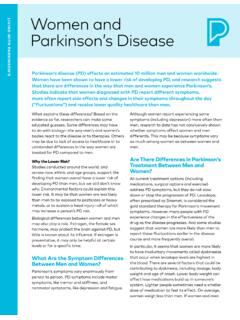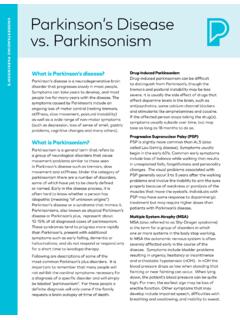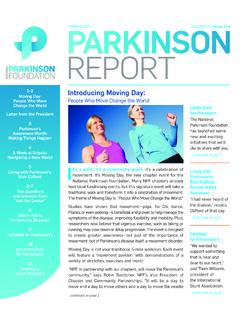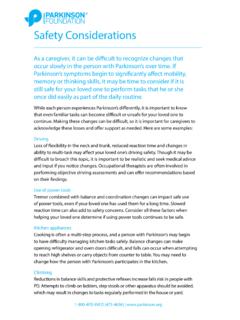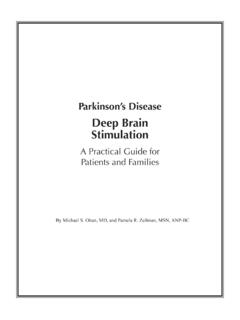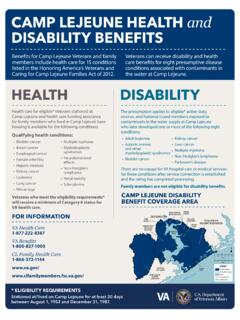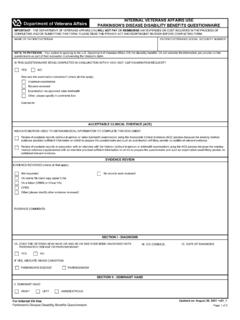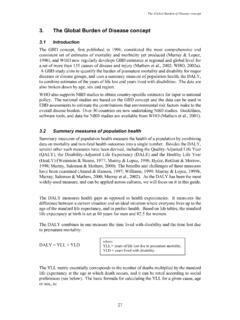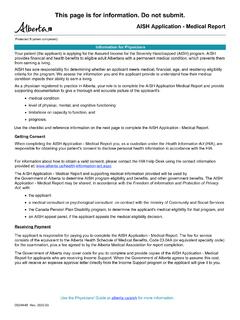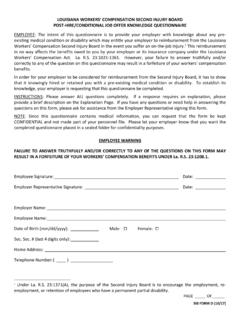Transcription of A Guide to Parkinson’s Disease
1 200 SE 1st StrEEt, SuitE 800 MiaMi, Florida 331311359 Broadway, SuitE 1509 NEw york, NEw york ( ) A Guide to parkinson s Diseaseparkinson s foundation resources You can find more helpful tips for managing parkinson s in the books, fact sheets, videos and newsletters in our PD library at about the parkinson s foundationThe parkinson s Foundation makes life better for people with parkinson s Disease by improving care and advancing research toward a cure. In everything we do, we build on the energy, experience and passion of our global parkinson s community. A wealth of information about parkinson s and about our activities and resources is available on our website, feedback matters!We d like to know what you think of our publications and programs. Please take a few moments to fill out our online feedback form.
2 Your answers will be used to improve our resources and will benefit people with parkinson s, caregivers, families and others in the parkinson s community. Thank you for your help. oNliNE ForM: generositY makes this publication parkinson s Foundation is proud to provide this booklet and other educational materials at no cost to people around the globe. If you found this book helpful, please consider a gift so that we may continue to fight parkinson s on all fronts: funding innovative research, providing support services and offering educational materials such as this publication. Thank you for your support. doNatE oNliNE: doNatE By Mail: parkinson s Foundation 200 SE 1st St, Suite 800 Miami, FL 33131 doNatE By phoNE: 1-800-4PD-INFO (473-4636) tax id: 13-1866796 The information contained in this publication is provided for informational and educational purposes only and should not be construed to be a diagnosis, treatment, regimen or any other healthcare advice or instruction.
3 The reader should seek his or her own medical or other professional advice, which this publication is not intended to replace or supplement. The parkinson s Foundation disclaims any responsibility and liability of any kind in connection with the reader,s use of the information contained herein. 2018 People affected by parkinson s Disease (PD) those living with parkinson s, their family members, their friends and the healthcare professionals that care for them are all looking for answers to questions about the Disease , its symptoms and treatments. This booklet is a compilation of the most frequently asked questions that the parkinson s Foundation receives through its Helpline. Some of these questions have simple answers, while others have complicated answers that are still each question is answered as comprehensively as possible, it is important to note that parkinson s is truly an individualized Disease .
4 Each person s experience with parkinson s, including its symptoms and the rate at which it progresses, is different. Not all people living with parkinson s will experience all of the symptoms and side effects discussed in this booklet. Rather, each person may find that certain symptoms are more troublesome and may experience these symptoms at different points in the you have additional questions that you would like to discuss, please call our Helpline at 800-4PD-INFO or email us at Mid-Stride 7 ContentsLiving with parkinson s 39 Finding Support 39 Staying Independent 40 The Family & parkinson s 42 Understanding parkinson s 5 Overview 5 What Happens in parkinson s? 8 Motor Symptoms & Complications 11 Non-motor Symptoms 18 2 Treating parkinson s 27 Finding a Doctor 27 Medications & Surgical Treatments 28 Complementary & Alternative Therapies 35 Exercise & Nutrition 37 parkinson s Research: The Future 44 Drug Discovery & Development 44 Playing a Part in Research 46 Finding the Cure 483 This book has been made possible through the generous donations of thousands of individuals affected by parkinson : Ultravirgo4 chapter oneUnderstanding parkinson sOverviewWhat is parkinson s Disease ?
5 parkinson s Disease (PD) is a chronic and progressive movement disorder that involves the malfunction and death of vital nerve cells in the brain, called neurons. Some of these dying neurons produce dopamine, a chemical that sends messages to the part of the brain that controls movement and coordination. As PD progresses, the amount of dopamine produced in the brain decreases, leaving a person unable to control movement s was originally described in 1817 by James parkinson in his Essay on the Shaking Palsy. It is not considered a fatal Disease and the way it progresses is different for each motor signs of parkinson s Disease include tremor, slowness, rigidity and postural instability. Most people with parkinson s also experience non-motor symptoms that may precede motor symptoms and a PD diagnosis by years.
6 The most recognizable early symptoms include loss of sense of smell, constipation, mood and sleep disorders, and neurogenic orthostatic hypotension (low blood pressure when standing up). Learn more about symptoms on page many people are currently living with parkinson s Disease ?Worldwide, there are more than 10 million people living with parkinson s Disease . In the United States (US), as many as one million people live with parkinson s, which is more than the combined number of people with multiple sclerosis, muscular dystrophy and ALS. Approximately 60,000 Americans are diagnosed with PD each year. This number does not reflect the thousands of cases that go is the average age of PD diagnosis?The average age at which someone is diagnosed is 60. Incidence of PD increases with age, but an estimated four percent of people with PD are diagnosed before the age of 50.
7 This is referred to as young-onset PD. Although symptoms are similar, people with young-onset PD often face different financial, family and employment parkinson s be cured?The answer is no not yet. However, many symptoms of parkinson s Disease can be treated and researchers are making advances in understanding the Disease , its causes and how to best treat is parkinson s versus parkinsonism?Because there are no definitive diagnostic tests for parkinson s, the diagnosis can sometimes be unclear. The term parkinsonism is a generic descriptive term that refers to the whole category of neurological diseases that causes slowness of movement. This category includes the classic form of parkinson s Disease , many atypical variants, sometimes called parkinson s Plus Syndromes, and any other brain Disease that resembles parkinson s, such as normal pressure hydrocephalus, vascular parkinsonism or drug-induced parkinsonism.
8 In all cases of parkinsonism, there is a disturbance in the dopamine systems of the basal ganglia a part of the brain that controls movement. This dopamine deficiency leads to the characteristic combination of tremor, slowness, rigidity and postural (idiopathic) parkinson s is the most common and most treatable form of parkinsonism. For a significant minority, about 15 percent of all persons with parkinsonism, one of the atypical variants may be present. These conditions are more serious and less treatable than classic PD, and include multiple system atrophy (MSA), progressive supranuclear palsy (PSP), corticobasal degeneration (CBD) and Lewy Body more information, visit or call tpnvs ervk ?ipHow is parkinson s diagnosed?Often, the diagnosis of parkinson s is first made by an internist or family physician.
9 Many people seek an additional opinion from a neurologist with experience and specific training in the assessment and treatment of PD referred to as a movement disorder diagnose parkinson s, the physician takes a careful neurological history and performs an examination. Although there are no standard diagnostic tests for parkinson s, DaTscan, an imaging technology, may provide beneficial insights to help a doctor confirm a PD diagnosis in the early stages of the Disease . The main role of any additional testing is to exclude other diseases that imitate parkinson s Disease , such as stroke or mild cases of PD can be difficult to confirm, even by an experienced neurologist. This is in part because there are many neurological conditions that mimic the appearance of parkinson parkinson s Foundation recommends that a person with symptoms resembling those of PD consider making an appointment with a movement disorder specialist.
10 Learn more about how to find a parkinson s specialist on page are the stages of parkinson s?The stages of parkinson s correspond both to the severity of movement symptoms and to how much the Disease affects a person s daily activities. At all stages of parkinson s, effective therapies are available to ease symptoms and make it possible for people with PD to live mild parkinson s, movement symptoms, often tremor, occur on one side and may be inconvenient, but do not affect daily activities. Friends may notice changes in a person s posture, walking ability or facial expression. Regular exercise improves and maintains mobility, flexibility, range of motion and balance, and also reduces depression and constipation. With moderate parkinson s, movement symptoms occur on both sides of the body. The body moves more slowly and trouble with balance and coordination may develop.
